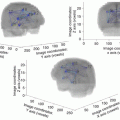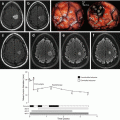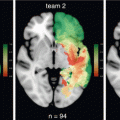Fully validated in clinical trials
• Age >40 years
• Presence of neurological deficits and/or absence of seizures at onset
• Low performance status (Karnofsky <70)
• Preoperative tumor diameter >4–6 cm
• Astrocytoma as histology
Needing validation in clinical trials
• Presence of contrast enhancement on MRI
• Preoperative and postoperative tumor volumes on MRI
• High speed of volumetric increase or velocity of diametric expansion (VDE) on MRI
• Elevated cerebral blood volume values (CBV) on MRI perfusion
• High uptake of aminoacids on PET.
Table 17.2
Prognostic value of molecular markers in low grade gliomas
Markers | Method of assessment | Prognostic value |
|---|---|---|
p53 mutation | PCR and immunohistochemistry | Minimal/absent |
IDH 1 and 2 mutations | Immunohistochemistry/pyrosequencing | Prognostically favorable; possibly predictive with regard to radiotherapy or chemotherapy |
1p/19q codeletion | PCR, FISH | Prognostically favorable; possibly predictive with regard to radiotherapy and chemotherapy |
MGMT promoter methylation | Methylation-specific PCR | Prognostic or predictive depending on treatment received or molecular subtypes |
BRAF mutations | PCR | Unknown |
ATRX loss TERT mutations | Immunohistochemistry/pyrosequencing | Still to be validated |
17.3 Prognostic Factors
17.3.1 Age
Younger age is a well-established prognostic factor for survival [8, 28–30]. Early in the eighties Laws et al. [25], in a retrospective study involving 461 patients with LGGs treated at the Mayo Clinic, found that patients who were younger than 20 years had a 5-year survival of more than 80%, with a progressive decrease in survival of 60% to 35% for those in the 20–50 years age group and of less than 30% for those in the over 50 age group. The linear functional relationship between age and prognosis has been confirmed in large datasets from prospective randomized trials [15, 31, 32]. A cut point at 40 years has been more commonly found, but in the clinical practice this should not be interpreted as an absolute cut off value. A reluctance to undertake large resections (thus under-sampling a higher grade component of the tumor) in older patients could potentially contribute to a worse prognosis, even in patients with an imaging appearance of a low grade tumor. On the other hand tumor biology may differ in older patients, being the tumors inherently more aggressive. In this regard it has been reported that the proliferative index is higher and malignant transformation more frequent among patients with astrocytomas with an age >40–45 years [33]. Moreover, the proportion of gemistocytes in astrocytic tumors, that could be associated with a more aggressive behavior, increases with age [34]. Ultimately, although the biology behind the association of older age and worse outcome is still unclear, a possibility is that an age-dependent impairment of DNA repair mechanisms and the resulting acquisition of mutations may promote rapid progression after transformation occurs [35].
17.3.2 Clinical Presentation
Clinical presentation is another strong prognostic factor, whether expressed as the presence of seizures, absence of neurological deficits or good performance status [25, 26, 36–40]. These factors are inter-related, e.g. neurologically intact patients who present with isolated seizures have a better performance status and prognosis. Moreover, patients who present with seizures tend to be younger and have smaller tumors than those without seizures [41–43]. It has been hypothesized that LGGs associated with epilepsy might differ biologically from LGGs of patients presenting with neurological deficits [44]. The duration of symptoms before diagnosis has been suggested as an independent predictor of time to recurrence [45]. The presence of an abnormal Mini-Mental State Examination (MMSE) has been found as a strong predictor of poorer progression-free and overall survival in a large dataset of patient treated with adjuvant radiotherapy [46, 47]. Seizure reduction has been reported as an early and consistent prognostic marker for progression-free (PFS) and overall survival (OS) after treatment with temozolomide [48].
17.3.3 Structural Neuroimaging Findings
Conventional neuroimaging findings have some prognostic importance. A tumor diameter >4–6 cm [40, 49, 50] and a tumor crossing the midline [40] correlate with a short PFS and OS. Several investigators in nineties [27, 51, 52] have reported a tendency for larger tumors to behave differently with an earlier recurrence risk and/or greater tendency toward malignant transformation.
Tumor volume measurement on MRI has been increasingly used to study the relationships with outcome. Kreth et al. [52] found preoperative tumor volume greater than 20 ml to be of unfavorable prognostic significance, with the presence of midline shift being correlated with volume. In a recent study of hemispheric LGGs [53] greater preoperative and postoperative tumor volume was significantly associated with shorter malignant progression-free survival.
Growth rates, measured with different methods, are inversely correlated with survival [23, 54, 55] and early malignant transformation [24, 56, 57]. Among 143 consecutive patients with LGGs in adults, a median survival of 5.16 years was associated with a growth rate of 8 mm/year or more compared with a median survival of >15 years with a growth rate of less than 8 mm/year [54]. Other investigators have demonstrated that sequential measurements of LGG volume, by allowing a precise determination of growth rates, permits the identification of patients whose tumors are at high risk for an early malignant transformation [57]. Six-month tumor growth may also predict outcome in patients with LGGs [56]. However, the lack of widespread availability of volumetric assessments preclude their implementation in clinical trials thus far [58], although progress in imaging software is likely to make routine implementation possible in the near future.
The prognostic implication of contrast enhancement on either CT or MRI remains controversial. Contrast enhancement occurs when the blood-brain-barrier is disrupted and a lack of contrast enhancement more often suggests a low grade gliomas diagnosis [59]. However, contrast enhancement is reported in 15–50% of patients with low grade gliomas [21, 51, 60–62]. The finding that contrast enhancement is more commonly seen in high-grade gliomas has led many authors to infer that contrast-enhancing low grade gliomas represent a more malignant subset of low grade gliomas. Most articles on contrast enhancement and low grade gliomas derive from series in which both CT and MRI were used, and have concentrated on the relationships with survival, while there is paucity of information regarding the association with tumor recurrence and malignant transformation. The presence of contrast enhancement has been reported either as a negative factor for survival [30, 37, 63–65] or as without prognostic significance [8, 38, 66, 67]. Two recent papers have analyzed the prognostic significance of contrast enhancement in the MRI era, and the results are still somewhat different. In the experience of Chaichana et al. [61] at John Hopkins on 189 patients with LGGs who underwent surgical resection preoperative contrast enhancement was independently associated with decreased survival, increased recurrence and a trend toward increased malignant transformation in multivariate analysis. Five-year overall survival, progression-free survival and malignancy-free survival rates for patients with contrast-enhancing versus non-enhancing tumors were 70 versus 85%, 32 versus 49% and 74 versus 90%, respectively. Notably in this series patterns of survival, recurrence and malignant transformation were not significantly different between contrast-enhancing fibrillary astrocytomas and contrast-enhancing oligodendrogliomas. Pallud et al. [62] reviewed 927 histologically proven (either after biopsy or resection) WHO grade II gliomas in the French Glioma Database, and found that the presence of contrast enhancement was not significantly associated with a poorer prognosis in multivariate analysis: median survival and surviving rates at 5, 10 and 15 years were 11.9 years, 79.1%, 68.5% and 27.8% for patients with contrast enhancement compared to 12.7 years., 83.2%, 60.3% and 44.3% for those without contrast enhancement. Conversely, in univariate analysis, the presence of a nodular-like pattern and a progressive contrast enhancement over time were statistically associated with shorter survival.
Overall, the persistent discrepancies among the different series can be accounted by several factors, such as a different rate of sampling errors leading to the inclusion of a variable percentages of high grade tumors and the absence of reproducible criteria to quantify the different degrees and characteristics of contrast enhancement prospectively. In this regard, it has been suggested that a quantification of the volume of substable contrast enhancement at baseline MRI could identify individuals at high risk for transformation [68].
17.3.4 Physiologic Neuroimaging Findings
The emergence of physiological imaging techniques has added new perspectives for the prediction of outcome and malignant transformation in LGGs.
Proton MR spectroscopy allows the quantification of the levels of cellular metabolites: normalized creatine/phosphocreatine levels have been reported as significant prognostic factors for PFS as well as time to malignant transformation [69].
The measurement of relative cerebral blood volume (rCBV) derived from dynamic susceptibility-weighted perfusion contrast-enhanced MRI (DSC-MRI) could predict tumor behavior: a low rCBV correlates with longer PFS and OS [70, 71]. A longitudinal magnetic resonance perfusion imaging study was performed on conservatively treated LGGs to determine whether rCBV changes preceded malignant transformation as defined by conventional MR imaging [72]. In patients with non-transforming LGGs the rCBV remained relatively stable and increased to only 1.52 of normal tissue over a mean follow-up of 23 months. In contrast, patients with transforming LGGs showed a continuous increase in rCBV up to the point of transformation when contrast enhancement became apparent on conventional MRI. The mean rCBV was 5.36 at transformation and showed a significant increase from the initial study at 6 and 12 months before transformation. The measurement of rCBV correlates well with time to progression among low grade astrocytomas, while it is not useful in oligodendrogliomas, as these tumors have an abundant vasculature which is not a sign of malignant evolution.
According to a recent meta-analysis lower ADC values on MRI diffusion can predict a worse prognosis independent of tumor grade [73].
17.3.5 PET Findings
PET with FDG is of limited value for prognostic purposes since LGGs show a low FDG uptake compared to the normal cortex. Conversely, PET with aminoacid tracers is more useful, as the uptake of tracers is increased in approximately two-thirds of patients with LGGs, and correlates with the proliferative activity of tumor cells [74, 75]. A low uptake of 11C-methionine has been initially correlated with longer survival [75–78] and among high-risk patients with LGG (as defined by the presence of 3–5 unfavorable clinical prognostic factors) those with high Met uptake had a worse outcome than patients with low Met uptake [79]. A reduction of tumor uptake following chemotherapy with temozolomide has been recently reported to occur earlier than standard MRI changes and significantly predict the duration of PFS, and to better correlate with seizure reduction [80]. Similarly to CBV values with perfusion MRI, the uptake of Met is physiologically relatively higher in low grade oligodendrogliomas compared to astrocytomas: thus, the prognostic value of PET Met seems restricted to astrocytomas.
PET with FET (18-fluoroethyltirosine) is similar to PET Met and has been reported with a similar prognostic value [81]. Moreover, dynamic 18F-FET PET can identify highly aggressive astrocytomas within the same WHO grade II category: tumors with decreasing time-activity curves manifested earlier tumor progression, malignant transformation as well as shorter survival [82, 83].
The prognostic value of uptake when employing tracers such as F-DOPA or FLT (18F- fluorothymidine) is still unknown.
17.3.6 Histology and Proliferation Markers
Oligodendrogliomas have a better prognosis than astrocytomas, being oligoastrocytomas in between [8, 21, 31, 40, 84]. The median survival for patients with oligodendrogliomas is typically 10–15 years compared to 5–10 years for those with astrocytomas. Among diffuse astrocytomas the gemistocytic variant has a poorer outcome [85]. Some investigators have associated the clinical behavior and rates of proliferation of low grade astrocytomas with a different cellular lineage [86]: slow growing, cortically-based astrocytomas would be associated with a type 1 (protoplasmic) astrocytic lineage, whereas white matter astrocytomas would express antigens consistent with a type 2 (fibrillary) astrocytic lineage.
The difficulties in predicting the prognosis of low grade gliomas have led to the increasing use of proliferation markers as an adjunct to routine histological techniques. Historically, different methods have been used to estimate the proliferative activity of low grade gliomas: silver staining of nuclear organizer regions (AgNORs) (a measure of ribosomal gene activity that correlates with the degree of tumor malignancy [87]; evaluation of proliferating cell nuclear antigen (PCNA) [88]; analysis of the S-phase fraction by flow cytometry [89, 90]; immunohistochemical investigation of bromodeoxyuridine and iododeoxyuridine labeling index [91, 92]. However, the most commonly used techniques up to date is the immunohistochemical evaluation of the MIB-1 monoclonal antibody to the Ki-67 nuclear antigen to stain cells undergoing active division. Several studies have reported an association between high Ki-67 labeling index (≥3–5%) and shorter survival [93–95], even if the independent prognostic value of Ki-67 has not yet been proven. It has been recently suggested that mitotic index could be significantly associated with outcome in IDH wild type tumors only [96]. Still unresolved issues are the best techniques, the inter-observer variability, the heterogeneity of Ki-67 within a tumor specimen, and the variability in cutoff values within the different studies [97].
17.3.7 Molecular Factors
Positive TP53 mutation status (but not P53 overexpression/accumulation) was suggested to be an independent unfavorable predictor of progression-free and overall survival [98], but in contemporary studies from the German Glioma Network the P53 status was not associated with progression-free survival in tumors managed by surgery alone [99]. Accordingly, at present there is no need to know the P53 status for any clinical-decision.
IDH 1 and 2 mutations are the strongest prognostic factors in low grade gliomas: in particular patients without IDH mutations (30–35%) have a poorer survival compared to those with the mutation (65–70%) [99–101]. Conversely, the predictive value of IDH mutations respective to response to non surgical treatments is still to be proven [102].
1p/19q codeletion, that is commonly associated with the oligodendroglial phenotype and IDH 1 and 2 mutations, predicts longer overall survival [47, 103–106]. 1p/19q codeletion does not confer any prognostic advantage in terms of progression-free survival in patients with LGGs who received surgery alone [107]. Conversely, it could predict better response and longer progression-free survival in temozolomide-treated patients [24].
MGMT promoter methylation, which is commonly associated with IDH 1 and 2 mutations [108], could influence differently the progression-free survival depending on the treatment received, being a negative prognostic factor in patients with astrocytomas treated by surgery alone [109] and a positive prognostic factor in patients receiving temozolomide [110, 111].
The independent prognostic value of ATRX loss and TERT mutations is still to be defined.
BRAF mutations are rare in diffuse low grade gliomas; conversely, BRAF V 600E is found in approximately 60–70% of pleomorphic xanthoastrocytomas and 20% of gangliogliomas [112]. So far, there is no data on a prognostic relevance of BRAF mutations. Recently, the activation of the Akt-mTOR pathway has been suggested to correlate with a poorer outcome [113].
17.4 Prognostic Scoring Systems
Based on the prognostic factors that emerged as significant after multivariate analysis among large, randomized multicenter trials, several prognostic scoring systems have been developed to identify subgroups of patients with different outcome (so called low and high risk groups).
In the EORTC analysis [40] age >40 years, astrocytic tumor type, tumor size >6 cm tumor crossing the midline and neurological deficits at diagnosis had an independent negative prognostic value. A favorable prognostic score was defined as no more than 2 of these adverse factors and was associated with a median survival of 7.7 years, while the presence of 3–5 adverse factors was associated with a median survival of 3.2 years only. The EORTC prognostic score has been recently validated in database of NCCTG in US, and have yielded similar results [47]. However, in the American dataset the histology and tumor size had the maximal importance.
Another LGG preoperative prognostic scoring system has been developed at UCSF [49], based upon the sum of points given to the presence of 4 significant adverse prognostic factors (1 point per factor): location of tumor in presumed eloquent location; KPS score ≤80; age >50 years; tumor diameter >4 cm. Tumors with scores 0 or 1 had a 97% 5-year survival compared to 56% for those with score 4. This scoring system accurately predicted overall survival and progression-free survival in a multi-institutional population of patients [114].
17.5 Conclusions
Future clinical trials on lower grade gliomas will be designed based on molecular factors and not on traditional histological categorization as inclusion criteria. The hope is to be able to increasingly develop personalized treatment approaches in the daily clinical practice as well.
References
1.
Schiff D, Brown PD, Giannini C. Outcome in adult low-grade glioma: the impact of prognostic factors and treatment. Neurology. 2007;69:1366–73.PubMed
2.
Rudà R, Trevisan E, Soffietti R. Low-grade gliomas. In: Grisold W, Soffietti R, editors. Neuro-oncology, Handbook of clinical neurology, vol. 105. Edinburgh: Elsevier; 2012. p. 437–50.
3.
Claus EB, Black PM. Survival rates and patterns of care for patients diagnosed with supratentorial low-grade gliomas: data from the SEER program, 1973–2001. Cancer. 2006;106:1358–63.PubMed
4.
Soffietti R, Baumert BG, Bello L, von Deimling A, Duffau H, Frenay M, et al. Guidelines on management of low-grade gliomas: report of an EFNS-EANO task force. Eur J Neurol. 2010;17:1124–33.PubMed
5.
Louis DN, Perry A, Reifenberger G, von Deimling A, Figarella-Branger D, Cavenee WK, et al. The 2016 world health organization classification of tumors of the central nervous system: a summary. Acta Neuropathol. 2016;131:803–20.PubMed
6.
Reuss DE, Sahm F, Schrimpf D, Wiestler B, Capper D, Koelsche C, et al. ATRX and IDH1-R132H immunohistochemistry with subsequent copy number analysis and IDH sequencing as a basis for an “integrated” diagnostic approach for adult astrocytoma, oligodendroglioma and glioblastoma. Acta Neuropathol. 2015;129:133–46.PubMed
Stay updated, free articles. Join our Telegram channel

Full access? Get Clinical Tree






